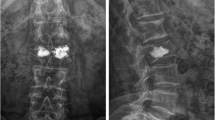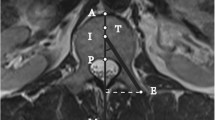Abstract
Objective
To study the distribution of bone cement in unilateral puncture percutaneous vertebroplasty (PVP).
Material and methods
A total of 64 patients with osteoporotic vertebral compression fractures (OVCF) who underwent unilateral PVP were included in this study. The vertebral body was longitudinally divided into four equal parts. The intermediate layer between each part was representative of the part and there were four layers in total. Each layer was divided into 4 regions a, b, c, and d by the crossed lines at the center of the vertebral body. Region c was the first half of the puncture side and region d was the second half of the puncture side. Region a was the first half of the opposite side, and b was the second half of the opposite side. Bone cement filling areas in the four layers and the four regions of each layer were compared.
Results
There were significant differences in visual analogue scale (VAS) scores before and after surgery (P < 0.05). Variance analysis indicated that the bone cement filling ratio of the region b in each layer was significantly lower than the other three regions, and that the bone cement filling ratio of region a was equal to that of the region d.
Conclusion
Unilateral puncture PVP can reduce VAS scores, and plays a role in reducing pain. The bone cement showed a regular distribution.
Zusammenfassung
Ziel
Die Verteilung des Knochenzements bei unilateraler Punktion im Rahmen der perkutanen Vertebroplastik (PVP) sollte untersucht werden.
Material und Methoden
In die Studie wurden insgesamt 64 Patienten mit osteoporotischen Wirbelkörperfrakturen eingeschlossen, die eine unilaterale PVP erhielten. Der Wirbelkörper wurde longitudinal in vier gleiche Teile untergliedert. Die Intermediärschicht zwischen jedem Teil war typisch für den Teil. Insgesamt gab es vier Schichten. Jede Schicht wurde durch die gekreuzten Linien in der Mitte des Wirbelkörpers in die vier Regionen a, b, c und d unterteilt. Region c war die erste Hälfte der Punktionsseite, Region d war die zweite Hälfte. Region a war die erste Hälfte der gegenüberliegenden Seite, Region b war die zweite Hälfte. Bereiche mit Knochenzementfüllung in den vier Schichten und in den vier Regionen jeder Schicht wurden verglichen.
Ergebnisse
Die Werte auf der visuellen Analogskala (VAS) vor und nach dem operativen Eingriff unterschieden sich signifikant (P < 0,05). Wie Varianzanalysen zeigten, war das Knochenzementfüllungsverhältnis der Region b in allen Schichten signifikant geringer als in den anderen drei Regionen. Zudem war das Knochenzementfüllungsverhältnis der Region a gleich dem der Region d.
Schlussfolgerung
Die PVP mit unilateraler Punktion kann die VAS-Werte reduzieren und spielt eine Rolle in der Schmerzlinderung. Für den Knochenzement zeigte sich eine regelmäßige Verteilung.

Similar content being viewed by others
Abbreviations
- CT:
-
Computed tomography
- OVCF:
-
Osteoporotic vertebral compression fracture
- PVP:
-
Puncture percutaneous vertebroplasty
- VAS:
-
Visual analog scale
References
Kallmes DF, Comstock BA, Heagerty PJ, Turner JA, Wilson DJ, Diamond TH, Edwards R, Gray LA, Stout L, Owen S et al (2009) A randomized trial of vertebroplasty for osteoporotic spinal fractures. N Engl J Med 361(6):569–579
Nieuwenhuijse MJ, Bollen L, van Erkel AR, Dijkstra PD (2012) Optimal intravertebral cement volume in percutaneous vertebroplasty for painful osteoporotic vertebral compression fractures. Spine 37(20):1747–1755
Wang H, Sun Z, Wang Z, Jiang W (2015) Single-balloon versus double-balloon bipedicular kyphoplasty for osteoporotic vertebral compression fractures. J Clin Neurosci 22(4):680–684
Berenson J, Pflugmacher R, Jarzem P, Zonder J, Schechtman K, Tillman JB, Bastian L, Ashraf T, Vrionis F (2011) Balloon kyphoplasty versus non-surgical fracture management for treatment of painful vertebral body compression fractures in patients with cancer: a multicentre, randomised controlled trial. Lancet Oncol 12(3):225–235
Itshayek E, Miller P, Barzilay Y, Hasharoni A, Kaplan L, Fraifeld S, Cohen JE (2012) Vertebral augmentation in the treatment of vertebral compression fractures: review and new insights from recent studies. J Clin Neurosci 19(6):786–791
Chu W, Tsuei YC, Liao PH, Lin JH, Chou WH, Chu WC, Young ST (2013) Decompressed percutaneous vertebroplasty: a secured bone cement delivery procedure for vertebral augmentation in osteoporotic compression fractures. Injury 44(6):813–818
Nieuwenhuijse MJ, Van Erkel AR, Dijkstra PD (2011) Cement leakage in percutaneous vertebroplasty for osteoporotic vertebral compression fractures: identification of risk factors. Spine J 11(9):839–848
Chen Bailing XD, Yiqiang L et al (2011) Effects of cross-midline cement distribution on the stiffness of varied sites in compressive fractured vertebrae after unipedicular PKP: a biomechanical study. Chin J Spine Spinal Cord 21(2):118–121
Chen Tonglin YY, Peng Yinping et al (2015) Effect of bone cement dispersion in the vertebral fracture line on the percutaneous vertebroplasty treatment. Chin J Tissue Eng Res 19(21):3287–3291
Acknowledgements
This study was supported by Fuzhou science and technology project (2013-s-123-12).
Author information
Authors and Affiliations
Corresponding author
Ethics declarations
Conflict of interest
Q. Chen, L. Liu and G. Liang declare that they have no competing interests.
Ethical approval was given by the medical ethics committee of the Second Hospital of Fuzhou Affiliated to Xiamen University with the reference number 20160035. All procedures performed in studies involving human participants were in accordance with the ethical standards of the institutional and the national research committee and with the 1964 Helsinki declaration and its later amendments or comparable ethical standards. Informed consent was obtained from all individual participants included in the study.
Rights and permissions
About this article
Cite this article
Chen, Q., Liu, L. & Liang, G. Distribution characteristics of bone cement used for unilateral puncture percutaneous vertebroplasty in multiple planes. Orthopäde 47, 585–589 (2018). https://doi.org/10.1007/s00132-018-3527-6
Published:
Issue Date:
DOI: https://doi.org/10.1007/s00132-018-3527-6




